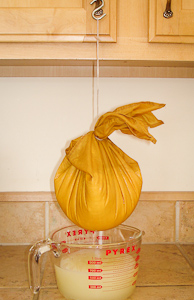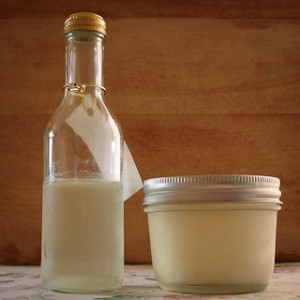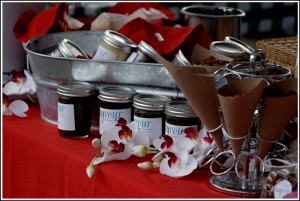Photo by Manon Gaudreau: whey and cream cheese
Cream cheese is the by-product of whey in this case, although most people view whey as the by-product of cheese-making!
Ingredients:
- 2 quarts raw milk, or 1 container of natural yogurt
Let raw milk stand at room temperature for 1-4 days in a glass container until it separates. For yogurt, use as is in the steps below.
Line a strainer with a clean dish towel and set it on top of a bowl. (After its use, rinse the towel with dish water, then let it dry until you wash it with your regular laundry. Alternatively, several layers of cheese cloth will do.)
Pour the separated milk, or the yogurt, into the lined strainer. The whey will start running into the bowl. Tie up the towel without squeezing and suspend over the bowl so that more whey can drip out. Let stand several hours (8-10 hours for yogurt, less for raw milk). When it stops dripping, store the whey and the cream cheese in glass jars in the refrigerator. The whey keeps for many months. Consume the cream cheese within one month or freeze it.
Note: Vegan non-dairy culture starters are available in specialized stores and online, as an alternative to whey. Some people tolerate whey even though they do not tolerate dairy products. Do not use commercial whey or dry whey, as they probably do not contain much live cultures. Most of the whey has already been removed from Greek yogurt, so you will not be able to squeeze much whey out of it.
The whey is used to inoculate many home fermented preserves like pickled cucumbers, cultured beet juice and plum sauce. It can also be used as a drink to provide pro-biotics , diluting 1 teaspoon per serving into water, juice or broth, or add to your warm soup (not hot – heat destroys the pro-biotics).
The cultured cheese can be used in many recipes: maple cream cheese to top muffins, a flavored dip for raw vegetables, herbed cheese spread, in lasagna, in soups and stews in lieu of sour cream.



